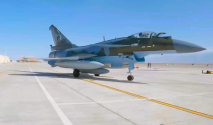You are using an out of date browser. It may not display this or other websites correctly.
You should upgrade or use an alternative browser.
You should upgrade or use an alternative browser.
J-10 Thread IV
- Thread starter Jeff Head
- Start date
Is it likely to be same model in service with the PLAAF?The radar has a much larger aperture than the one used on JF-17C. They won’t use that option.
Is it likely to be same model in service with the PLAAF?
I don’t see why not.
Was wondering if perhaps it got a downgrade similar to PL-15E, are we privy to radar model name of J-10C.I don’t see why not.
Hi,Was wondering if perhaps it got a downgrade similar to PL-15E, are we privy to radar model name of J-10C.
i don’t see any Eason for downgrading the radar, hence it’s not even in favour of China as
during a brief skirmish between IAF & PAF China doesn’t want its ace plane which been exported
first time to a foreign buyer to lack with anything
I am not exaggerating anything here but there isn’t any point of exporting PL15 (no point if this missile can’t overcome Meteor) downgraded version to PAF as been a Rafale opponent PAF want a upper hand to some extent.
thank you
According to this the J-10B radar is an AESA. As a first generation AESA it’s actually very heavy, similar to APG-63(V)2 which required 600 pounds of ballast to counter the radars weight. For the J-10 this lead to the development of the DSI inlet on later series J-10B and on (saves 200kg in weight from what I’ve read). Performance suffers from the weight gain.
So this gives some very interesting insight on both what kind of radar the J-10B has but also why the B had a limited run.
J-10B has an AESA but it’s very heavy, J-10C possibly has a more modern radar the doesn’t effect performance in the same way.
This is actually almost identical to the F-15
18 aircraft got the heavy APG-63(v)2 and tasked with cruise missile defense and the APG-63(v)3 saw much more widespread use and didn’t seem to require extensive modifications.
Not sure why those radar were so heavy, not all early AESA were heavy but it seems to have been a common issue.
So this gives some very interesting insight on both what kind of radar the J-10B has but also why the B had a limited run.
J-10B has an AESA but it’s very heavy, J-10C possibly has a more modern radar the doesn’t effect performance in the same way.
This is actually almost identical to the F-15
18 aircraft got the heavy APG-63(v)2 and tasked with cruise missile defense and the APG-63(v)3 saw much more widespread use and didn’t seem to require extensive modifications.
Not sure why those radar were so heavy, not all early AESA were heavy but it seems to have been a common issue.
According to this the J-10B radar is an AESA. As a first generation AESA it’s actually very heavy, similar to APG-63(V)2 which required 600 pounds of ballast to counter the radars weight. For the J-10 this lead to the development of the DSI inlet on later series J-10B and on (saves 200kg in weight from what I’ve read). Performance suffers from the weight gain.
So this gives some very interesting insight on both what kind of radar the J-10B has but also why the B had a limited run.
J-10B has an AESA but it’s very heavy, J-10C possibly has a more modern radar the doesn’t effect performance in the same way.
This is actually almost identical to the F-15
18 aircraft got the heavy APG-63(v)2 and tasked with cruise missile defense and the APG-63(v)3 saw much more widespread use and didn’t seem to require extensive modifications.
Not sure why those radar were so heavy, not all early AESA were heavy but it seems to have been a common issue.
I scanned the sina article and I cannot find any claim that J-10B uses AESA. That term (有源) appeared exactly once when describing F-15's APG-63.
I guess so, but PESA shouldn’t way much more if at all then a mechanical radar because the only necessary difference is antenna design I believe.I scanned the sina article and I cannot find any claim that J-10B uses AESA. That term (有源) appeared exactly once when describing F-15's APG-63.
The J-10B radar being PESA or AESA is the PLA watching equivalent to where Jimmy Hoffa is buried.
The actual story from what I’ve been told is that the J-10B radar was basically in between a proper AESA and a PESA. It wasn’t a single transmitter design but the number of transmitters were limited and not integrated into a T/R module package.I guess so, but PESA shouldn't way much more if at all then a mechanical radar because the only necessary difference is antenna design I believe.
The J-10B radar being PESA or AESA is the PLA watching equivalent to where Jimmy Hoffa is buried.
The actual story from what I’ve been told is that the J-10B radar was basically in between a proper AESA and a PESA. It wasn’t a single transmitter design but the number of transmitters were limited and not integrated into a T/R module package.
So it does the Irbis-E thing. In the end though it is not as a big of an advantage as people originally thought because it still lacks the EW resistance of proper AESA. J-11B with jammer pods can give it a hard time.

